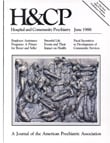Symptoms and Functioning of Patients With Bipolar Disorder Six Months After Hospitalization
Abstract
The relationship between symptoms and functioning of patients with bipolar disorder who were hospitalized for a manic episode was examined in a prospective study. At six-month follow-up, symptomatic outcome was clearly superior to functional outcome. Almost 80 percent of patients were symptom free or mildly symptomatic. However, only 43 percent of patients were employed, and only 21 percent were working at their expected level of employment. Thirty percent were rated as being unable to work. Additional analyses showed that 64 percent of the first-admission subjects were employed at some level at follow-up, compared with only 33 percent of subjects with multiple admissions. The results suggest that factors other than symptoms are related to the functioning of patients with bipolar disorder and that treatment should be targeted to the patient's disability as well to symptom amelioration.
Access content
To read the fulltext, please use one of the options below to sign in or purchase access.- Personal login
- Institutional Login
- Sign in via OpenAthens
- Register for access
-
Please login/register if you wish to pair your device and check access availability.
Not a subscriber?
PsychiatryOnline subscription options offer access to the DSM-5 library, books, journals, CME, and patient resources. This all-in-one virtual library provides psychiatrists and mental health professionals with key resources for diagnosis, treatment, research, and professional development.
Need more help? PsychiatryOnline Customer Service may be reached by emailing [email protected] or by calling 800-368-5777 (in the U.S.) or 703-907-7322 (outside the U.S.).



